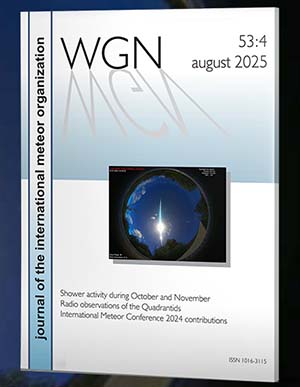January sees a peak of sporadic activity for the southern hemisphere while
rates seen north of the equator begin a steady downward turn that continues
throughout the first half of the year. The sporadic activity is good for
both hemispheres, but not as good as it was for northern observers in
December. Once the Quadrantids have passed the shower activity for January
is very quiet.
During this period the moon reaches its full
phase on Tuesday January 22. At this time the moon will be in the sky all night
long. Successful observations can be undertaken this weekend if your sky is clear
and transparent or one could wait until the moon lies low in the sky just before
dawn. The estimated total hourly rates for evening observers this week is near two
no matter your location. For morning observers the estimated total hourly rates
should be near nine for those located in the mid-northern hemisphere (45 N)
and eight for those viewing from the mid-southern hemisphere (45 S). These rates
assume that you are watching from rural areas away from all sources of light
pollution. The actual rates will also depend on factors such as personal light
and motion perception, local weather conditions, alertness and experience in
watching meteor activity. Rates are reduced this week due to intense moonlight.
The radiant positions and rates listed below are exact
for Saturday night/Sunday morning January 19/20. These positions do not change
greatly day to day so the listed coordinates may be used during this entire period.
Most star atlases (available at science stores and planetariums) will provide maps
with grid lines of the celestial coordinates so that you may find out exactly where
these positions are located in the sky. A planisphere or computer planetarium program
is also useful in showing the sky at any time of night on any date of the year.
Activity from each radiant is best seen when it is positioned highest in the sky,
either due north or south along the meridian, depending on your latitude. It must
be remembered that meteor activity is rarely seen at the radiant position. Rather
they shoot outwards from the radiant so it is best to center your field of view so
that the radiant lies at the edge and not the center. Viewing there will allow you to
easily trace the path of each meteor back to the radiant (if it is a shower member)
or in another direction if it is a sporadic. Meteor activity is not seen from radiants
that are located below the horizon. The positions below are listed in a west to east
manner in order of right ascension (celestial longitude). The positions listed first
are located further west therefore are accessible earlier in the night while those
listed further down the list rise later in the night.
The following showers are expected to be active this week:
The wide Antihelion (ANT) radiant is now centered at 08:48 (132) +16. This
area of the sky lies in southern Cancer, two degrees southeast of the fourth
magnitude star Delta Cancri. This radiant is best placed near 0100 local standard
time when it lies on the meridian and is highest in the sky. Actually any meteor
from Cancer or extreme western Leo could be a candidate for this shower. Rates at
this time should be near two per hour as seen from the northern hemisphere and one
per hour for observers located south of the equator. With an entry velocity of 30
km/sec., the average Antihelion meteor would be of medium-slow speed.
The Coma Berenicids (COM) are active from a radiant located at 13:28 (202)
+13. This area of the sky is located in a remote area of northern Virgo. The
nearest bright star is Arcturus (Alpha Bootis), located some twelve degrees
to the northeast. Current rates would be near less than one shower member per
hour no matter your location. These meteors are best seen near 0600 local
standard time when the radiant lies highest above the horizon. At 65 km/sec. the
Coma Berenicids will usually produce meteors of swift velocity.
Sporadic rates are now slowly falling for observers in the northern
hemisphere and have reached a first annual maximum for those located south of the
equator. One would expect to see approximately six random meteors during the
last hour before dawn from rural observing sites in the northren hemisphere and
seven from the southern hemisphere. During the first dark hour after the end of
evening twilight, perhaps two random meteors can be seen per hour, no matter your
location. Moonlight reduces rates during this period.
The table below presents a condensed version of the expected activity this week.
Rates and positions are exact for Saturday night/Sunday morning.
| SHOWER | DATE OF MAXIMUM ACTIVITY | CELESTIAL POSITION | ENTRY VELOCITY | CULMINATION | HOURLY RATE | CLASS* | RA (RA in Deg.) DEC | Km/Sec | Local Standard Time | North-South | Antihelion (ANT) | – | 08:48 (132) +16 | 30 | 01:00 | 2 – 1 | II | Coma Berenicids (COM) | Dec 20 | 13:28 (202) +13 | 65 | 06:00 | >1 – >1 | II |




 You saw something bright and fast? Like a huge shooting star? Report it: it may be a fireball.
You saw something bright and fast? Like a huge shooting star? Report it: it may be a fireball.  You counted meteors last night? Share your results with us!
You counted meteors last night? Share your results with us!  You took a photo of a meteor or fireball? You have a screenshot of your cam? Share it with us!
You took a photo of a meteor or fireball? You have a screenshot of your cam? Share it with us!  You caught a meteor or fireball on video? Share your video with us!
You caught a meteor or fireball on video? Share your video with us!